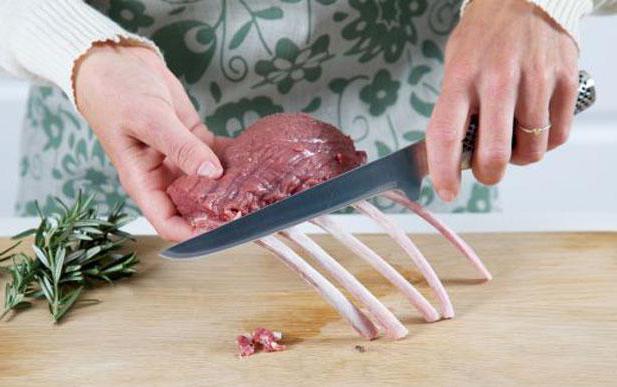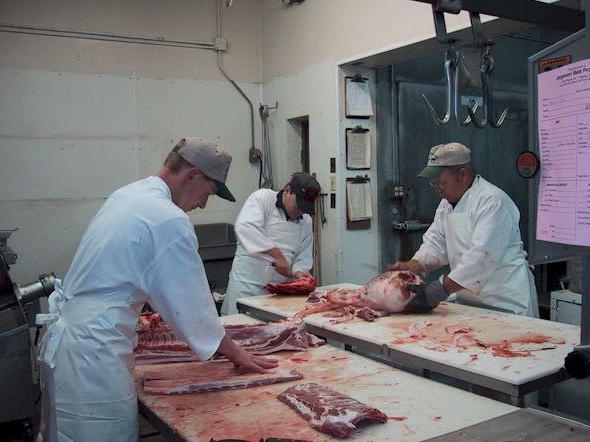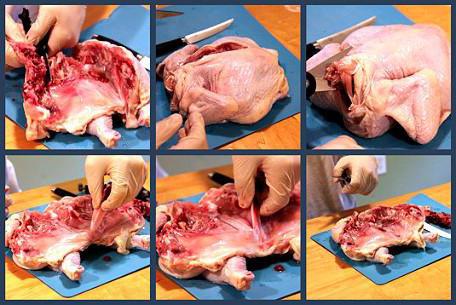In order for sausages to appear on store shelves, which attract buyers' attention with a mouth-watering appearance and alluring aroma, animal meat goes through a whole technological cycle. The main raw material is cut into cuts, subjected to veterinary examination, after which, in the case of a positive conclusion, meat is deboned, veined and sorted.
The whole process can be done manually or using equipment. But no matter how meat processing enterprises strive for automation, the profession of a meat cutter and meat-lodger remains in demand to this day.
Raw meat and its characteristics
For the production of semi-finished products, sausages and packaged products in Russia and Ukraine, beef, pork, chicken and, less often, mutton, horse meat, goat meat, venison are most often used.
Meat is a combination of bone, muscle, connective, fatty and nervous tissues, as well as blood and lymph vessels. Its components are proteins, fats, minerals and water. Due to the presence of proteins in it, the product has high nutritional value, therefore, the correct deboning of meat is very important when the standing flesh is maximally preserved when it is separated from the bones.

In each type of meat, the ratio of tissues is different, for example, in pork a higher percentage of fat than in beef. In general, the chemical composition of the product is affected by the breed, age, gender and fatness of the animal. A small amount of fat in meat increases the value of the product. So, marble meat is considered to be the most tasty morsel, in the muscle fibers of which there is a fat layer.
The main stages of processing
As mentioned earlier, the processing of raw materials occurs in several stages. Meat processing enterprises for these stages have corresponding workshops. It all starts with a cattle farm, where animals before slaughter are provided with the necessary conditions for rest, so that the meat is then of proper quality and does not deteriorate. From there, the cattle goes to the slaughterhouse and enters the meat cutting workshop.

During cutting, half carcases are divided into cuts. Moreover, if it is beef, then half carcasses are divided into seven parts, pork according to the standard scheme - into three, and mutton - into two cuts. All this happens on overhead tracks or on a conveyor. Then, deboning and trimming of meat of carcasses are performed.
The purpose of the boning is to separate the flesh with minimal cuts from the bone. The trimming workshop specializes in stripping meat from contaminants, films, small bones, blood vessels, cartilage and tendons. The final stage of the whole process of processing is sorting, when the trimmed parts of the carcass are assigned a grade.
Pulp production
As we have already said, meat boning is one of the technological processes of processing raw materials, as a result of which muscle tissue is separated from the bones. This work requires knowledge of animal anatomy, as knife movements must be considered. The deboner needs to know where to direct him in order to quickly separate the flesh from the bone.

Pork, beef, parts of poultry, lamb, and indeed any meat raw materials must be deboned. Carcases, half-carcases after defrosting, if they were frozen, undergo this process. Special cutting tools are used for it if deboning is done manually. Large enterprises at this stage of meat processing can be used conveyors, pneumatic tools and circular saws.
Types of boning
Boning is carried out in several ways:
- Differentiated method.This is when a specific part of a half carcass is assigned to each boner.
- Vertical boning. Work with vertically suspended half-carcasses when it slowly moves on the conveyor.
- Differentiated vertical carcass processing. It implies the successive actions of dealers on one conveyor over one carcass.
- The combined method. This is the separation of meat on the complex anatomical parts of the carcass, when it is allowed to leave the flesh on the bone, but not more than 50%.
- Extinguished boning. It implies the work of one specialist with the preliminary cutting of the carcass into cuts.
In the non-industrial version, carcass boning is used, and experienced craftsmen prefer the vertical method of separating meat from bones.
Boning meat
Knowing what deboning is, it will be interesting how to mechanically separate the bones and connective tissue from the muscles? It turns out that there are screw and reciprocating machines, through the filters of which the meat and bone masses are pressed and the output is a paste-like forcemeat. The quality of such a product, of course, is lower than the classical minced meat, for the production of which meat processing equipment is used. Nevertheless, the mechanical separation of meat is widely used in the production of sausages, since this makes it possible to roll carcasses more economically and faster than by hand.

In general, the mechanical preparation of an ingredient for future sausages and sausages has been actively used since the beginning of the 80s. The meat of mechanical boning in its composition has more fat than protein, in addition, small fragments of bones can be found in the product from such an ingredient, but this is allowed by the regulations.
Cutting tool
With manual boning, the result is affected by the quality of the cutting tools. Each specialist has his own individual knife. There are general characteristics for a deboning tool that must be followed by all manufacturers:
- The shape of the blade is selected according to the manufacturing operation. Its length for boning is 10-15 cm (for example, for trimming this parameter should be in the range from 23 to 30 cm). Knife manufacturers structure their products according to cutting operations and the type of raw materials, which simplifies the tool selection process.
- Blades made of high alloy carbon steel. Boning knives made with the addition of chromium, vanadium and molybdenum provide the blade with durability and give it strength. The hardness of the cutting element should be 57 units on the Rockwell scale. This makes it possible to sharpen and straighten the tool less often.
- The handle of the knife should be ergonomic for the worker and not affect his fatigue. The handle can be wooden, because it does not slip when wet, and knives with such a handle have a good balance. But sanitary standards many countries supplant such material because of the impossibility of high-quality processing of the junction of the blade with the handle of the knife and rivets.

Technological operation: boning of poultry meat
Manual cutting of hens often ends with mechanical deboning. Those who tried to decompose the chicken at home know how much meat remains on the bones. Therefore, manufacturers use meat processing equipment - screw presses for maximum benefit. The yield of raw materials on them is 65%, while with manual cutting - 25%.

The technological operation of cutting the bird looks like this:
- Cutting with a saw blade of a bird into parts.
- Chicken legs, wings and breast are sent to the packaging as products ready for sale.
- The skin with the skeleton is supplied for further mechanical processing to obtain minced meat;
- On technological tables equipped with halyards, the remaining skin is separated, which is then crushed in a top, while the frame is processed in a special press.
- After a fifteen-minute deboning, minced meat and bone residue are obtained.
For a nine-hour shift, a professional deboner cuts about 700 kg of layers.
Safety precautions
Boning meat requires caution and compliance with labor protection instructions by the employee. The danger lies in possible cuts during manual cutting and electric shock during mechanical deboning.
For example, when working with a knife for himself, the debris in the process of cutting carcasses risks getting cuts to the abdomen. When boning the scapula, neck, mopping up the pelvic part, when the thumb and forefinger of the left hand go deep into the meat, there is also the possibility of damage to the limb. 
Therefore, the worker must be provided with certain means of protection:
- an apron;
- gloves are chain mail and cotton;
- boots
- hard hat;
- arm ruffles.
So, a two-fingered metal glove is designed to protect the left hand, and a chain apron or apron ensures the safety of the case.








